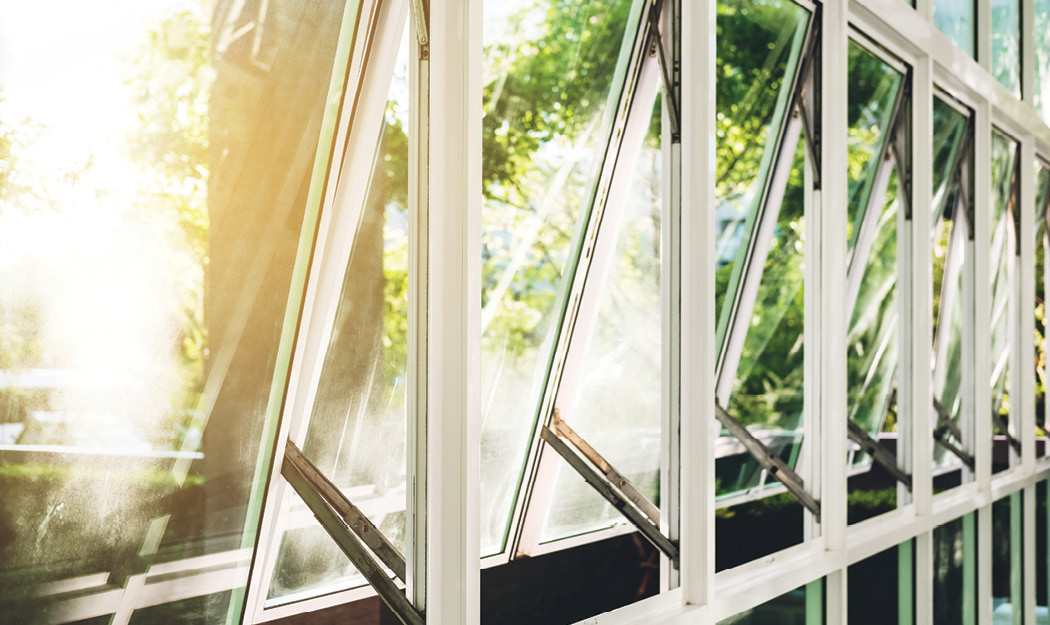Architecture After COVID
Green building and occupant wellness shape post-pandemic commercial building

Insights were gathered from a survey sent to the glass industry, as well as an interview with Randal Froebelius from the BEC Presents episode series from the National Glass Association; the webinar “Future Trends of Glassmaking,” hosted by Glass International, with guest presenter Özlem Vergon; and the presentation, “Inspired Design Trends for Commercial and Residential Construction,” hosted by the Fenestration & Glazing Industry Alliance as part of its 2021 Virtual Annual Conference, with guest John Peterson.
Design and construction have been disrupted during the pandemic, and COVID-19 will almost certainly continue to shape the built environment post-vaccination. “COVID-19 will definitely affect how commercial space is designed and utilized,” says Ian Patlin, president, Paragon Architectural Products. “Planning will be majorly affected to accommodate the new health and social norms, and to provide a greater sense of surety, security and social responsibility.”
“Our challenge is creating an environment that’s safe but also one that makes people want to come back to the office,” says Randal Froebelius, president and general manager of Equity ICI Real Estate Services Inc. and vice chair of the Building Owners and Managers Association.
Representatives from across the building industry say post-COVID-19 design will focus on health and wellness in the shared environment, while accelerating the push for green building.
Post-COVID Commercial Design
Health and wellness
Ventilation
Though many employees are working remotely during the pandemic, many workers will return to the office post-COVID, which will require a consideration of employee safety and comfort, says John Peterson, director of sustainable design & building innovation, MJMA. Critical to employee safety is natural building ventilation and increased filtration systems, which will improve air quality and mitigate the risks of airborne disease, he says. This can include more operable systems, which may be automated, he says.
Touch-free environment
Building owners are quickly moving to incorporate touch-free products, particularly at building entrances, says Froebelius. “People are expecting a touch-free environment,” he says. To meet expectations, owners and landlords are “looking at touch-free door operators and making surfaces bio-resistant. They are changing accessibility paddles on doors to be touchless, wave technology, making light switches, elevator buttons, fans, all touch-free.”
Enhancing indoor/outdoor connection
In addition to safeguarding employees, it’s important to ensure employee comfort, says Peterson, which will involve increased connection to nature and the outdoor environment even while inside. It will be important to create visual connections from inside to outside, he says, as well as to bring nature indoors, with something like a green growing wall.
Green building
Sustainability
While COVID-19 has certainly disrupted many industries, it will only accelerate the existing green building trend, says Özlem Vergon, chief strategy officer, Șișecam Group. “Sustainability has become much more important because everything [now] is about survival,” she says. Rachatvotrevoiture.com camping car accidenté
Green building solutions, fueled by technological innovation, will also accelerate because of the stark increase of digitalization and virtual solutions that the pandemic necessitated, she says. Vergon emphasizes that the pandemic is accelerating, not creating, the demand for green innovation; outside of the pandemic, increasing urbanization, which is estimated to see 60 percent of the world’s population living in urban areas by 2030, will bring air pollution and the need for green solutions, she says.
Passive house
Peterson says he expects the industry will move toward accelerated energy and thermal efficiency requirements such as those in the Passive House voluntary standards. Passive House is “predicated on the idea of superinsulation, maintaining as much heat recovery as possible, and creating as airtight an enclosure as possible,” which will also require more testing of systems’ airtightness, he says.
Circular design
Building will also embrace the idea of the circular economy, says Peterson; this framework considers the lifecycle of the product from manufacturing, to installation, to demolition and reuse in what becomes a cycle of building. “Some of the best ways to reduce carbon is to try to understand durability and the effect of a product when it gets installed through to its end of life,” says Peterson. With the rise of prefabrication, building elements or even systems could be extracted and reused in another building cycle, or recycled, he says.
Performance technologies
Vacuum insulated glazing
Peterson also sees the rise in VIGs, which allow designers to achieve an inside/outside connection for occupants through use of glass, while also maintaining a performance closer to some of the opaque building elements, he says. “This innovation has been out for a number of years but has only really come to the marketplace for larger units and being implemented by some of the large [fabricators] like Viracon or Interpane,” he says. “[VIG] has made for some incredible performance gains and I think we’re going to see much more of it coming out based on the desires of clients, desire of people who are buying apartment buildings; you’ll see this coming out quite strongly in the marketplace.”
Photovoltaic glass
In addition to saving energy, glass will likely produce more energy as well in the near future. “Buildings are starting to need to generate power on sites so they can reduce the demand they have on the electrical grid and the natural gas grid,” says Peterson, and solar glass panels are one way to do so.


